IFAA 2008 Exhibition at CBKG - Arnhem
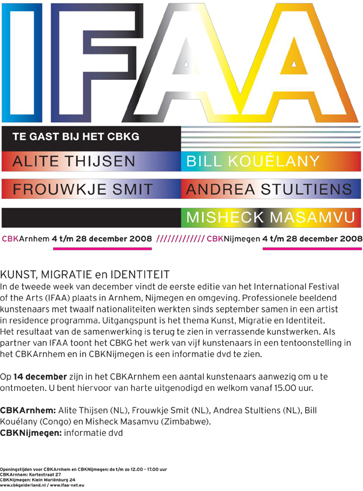
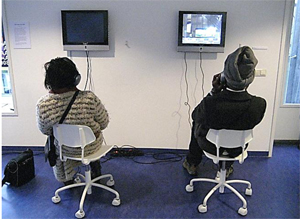 2008 video work by artist Alite Thijsen
2008 video work by artist Alite Thijsen
CBKG stands for Centre for Visual Arts in Gelderland. It was also the regional headquarters of the 8 cultural centers spread through the Gelderland region.
During IFAA 08, CBKG collaborated with IFAA as one of its Major exhibition partners. This made it possible for IFAA artists to show their work at the CBKG Arnhem and to also use CBK Nijmegen during the exhibition period of the whole IFAA project. Artists who exhibited at the CBK included: Frouwkje Smit, Bill Kouelany, Misheck Masamvu, Alite Thysen and Andrea Stultiens.
the CBK included: Frouwkje Smit, Bill Kouelany, Misheck Masamvu, Alite Thysen and Andrea Stultiens.
CBKG Arnhem; www.cbkgelderland.nl
During IFAA 08, CBKG collaborated with IFAA as one of its Major exhibition partners. This made it possible for IFAA artists to show their work at the CBKG Arnhem and to also use CBK Nijmegen during the exhibition period of the whole IFAA project. Artists who exhibited at
 the CBK included: Frouwkje Smit, Bill Kouelany, Misheck Masamvu, Alite Thysen and Andrea Stultiens.
the CBK included: Frouwkje Smit, Bill Kouelany, Misheck Masamvu, Alite Thysen and Andrea Stultiens.
CBKG Arnhem; www.cbkgelderland.nl
The below works were produced and exhibited during the 2008 Art, Migration and Identity project.
Works by artist Frouwkje Smit

Frouwkje smit; www.frouwkjesmit.nl
"Een kind onder de evenaar, wordt later vaak een bedelaar...."
"A child from south of the equator often later becomes a beggar...."
As a very young child you are already confronted with images and stories about the world around you, like this line from the opening song of ‘Children for Children' from 1980. This was the way she too learned to know the world, through the eyes of others. Until she was 19 and lived in Uganda for nine and a half months, I had to rely on the images and stories they gave me. Since that time in Uganda, she has become strongly aware of the power of those who shape our mental images. Our opinions are substantially influenced by the daily stream of pictures and stories that reach us. These images are often clichés, and serve to reinforce what we already 'know' rather than offering us new points of view. Particularly when it comes to ‘minorities' in our society, she becomes annoyed at the often biased coverage and negative images we are given.
My own mental image of at least a small part of Africa was formed in Uganda, and really that is still the thread that runs through her work. By opening herself up and immersing herself in the story of ‘the other', she tries to look beyond the clichés and learn to know the personal stories behind the stereotypes. The basis of her work is shaped by encounters, at home in The Netherlands and on her trips. Often these are encounters with people from different cultures. Her curiosity guarantees that she will become fascinated with these people who are rootless and adrift. By making a photo series or a film, she hopes to convey something of her own fascination, admiration and engagement with them. Often they are people who could be her friends; the bond that she builds up with them is an important point of departure for her work. Her work involves more than just ‘portraits' in which she records these encounters. She makes use of elements from her own visual culture or from the culture of her partner in the encounter.
IFAA 2008 paintings by Misheck Masamvu
‘I feel the need to highlight the changes
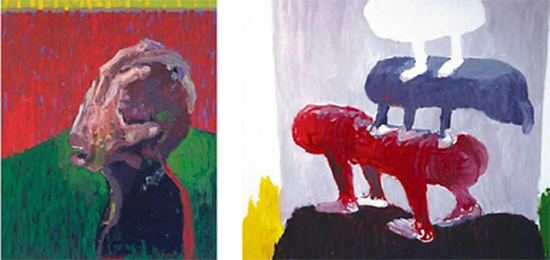 we have gone through as a nation without a partisan perception. I am optimistic that the subject matter carried through in my work may not be intentionally misread, but it may cause some discomfort in sensitive circles of the society.
we have gone through as a nation without a partisan perception. I am optimistic that the subject matter carried through in my work may not be intentionally misread, but it may cause some discomfort in sensitive circles of the society. I have been true to myself and I do not wish to compromise or exaggerate the extent of difficulties faced by many to this day. I wish to draw attention to intellectual decisions made in the halls of financial institutions that lack the humanistic spirit.
We paid, or rather; we are still paying the price of economical bad policies implemented to sustain a political mayhem. Should we rise from this current mis-step then collectively we should be encouraged to listen to one another carefully and disagree in peace. Neither should we hold on to the expertise we have and exploit the trust of those who rely on us.’
Born in 1980 in Penhalonga, Zimbabwe, Misheck Masamvu studied art with Helen Lieros at Gallery Delta in Harare. He then went on to study at the Kunstacademie in Munich. Masamvu questions the continent’s current trajectory by dramatically exposing psychosocial and political realities. His bold and furious brush work have been described as ‘expressionistic’ and clearly comment on the political and social ills of Zimbabwe, but ultimately his work is reflective of universal unease.
Works produced at the 2008 Art, Migration and Identity project by Bill Kouélany
Bill Kouélany was born in 1965 in Brazzaville, Congo Republic, where she lives and works. She is a writer, playwright and multi-media artist.
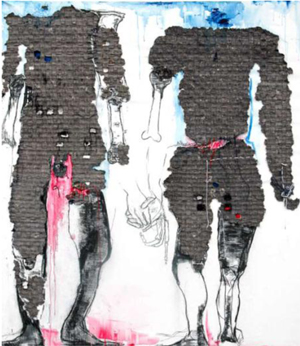 In her paintings, videos, photographic images and writings, she focuses on current events. She also reflects upon the potential violence inside every human being, leading to an intimate and critical exploration of the relationship between oneself and others.
In her paintings, videos, photographic images and writings, she focuses on current events. She also reflects upon the potential violence inside every human being, leading to an intimate and critical exploration of the relationship between oneself and others.
Peintre et écrivain, Bill Kouélany met très souvent enoeuvre dans ses travaux plastiques, non parfois sanshumour, l'idée ou la traduction violente d'uneimpossibilité. Orchestrant une matière chaotique, sespeintures renvoient à une exploration intime,questionnant le rapport à soi et à l'autre. Ses toilessont incisées, arrachées, rapiécées, elles sontl'endroit de la déchirure, elles s'éprouvent comme despeaux.(...)
Peuplés des corps anonyme et sans têtes, elles mettenten scène les spectacles d'un théâtre intérieur.Coutures volontairement grossières qui apparaissenttelles des cicatrices, collages qui se mêlent auxtraits simples et aux couleurs brutes, ces formes sontles traces d'un journal de bord existentiel etamoureux, ou s'exacerbent une tension, le désir dejoindre ce qui semble inconciliable. L'artisteentreprend sans relâche et presque amusée, lanarration fluctuante de ces atermoiements.

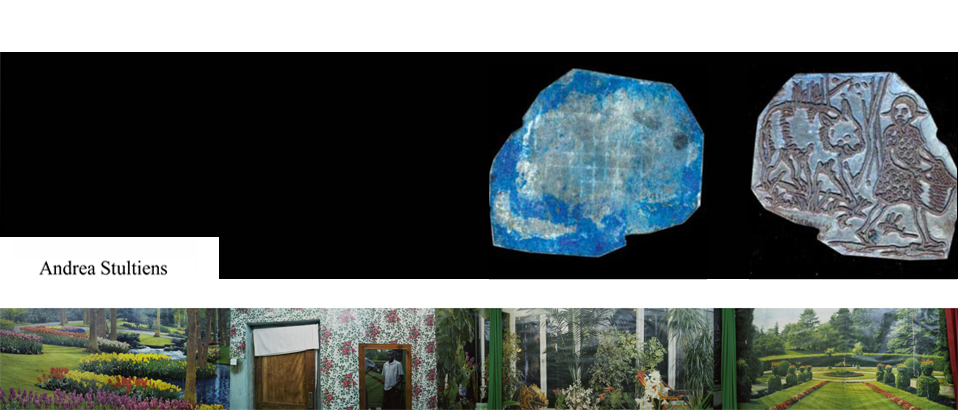
Somehow I am not completely at ease with calling myself a photographer. Instead I describe myself as someone doing things with photographs. I make them, collect them, look at them, think and write about them. Sometimes I make the results of this visible for the rest of the world online, in books or in exhibitions. All of this is aimed at telling relevant stories about the way we deal with the world, while it is also a continuing research into how we represent ourselves and that same world in photographs.
When I realized that my photographs are only one take on the world, that is female, of a certain time and place, with eyes on about 1.6meters high, I started to work with archival material. Images that I found added other dimensions in time and perspective to the photographs I made. At the moment my work often starts with an existing collection of photographs, or at least an existing story that I try to tell by editing and adding to what is already there.
The work I do focuses at the moment on urban areas in transition (in the US and the Netherlands), and on the production of alternative version of the representation of Ugandan history.
Alite Thijsen
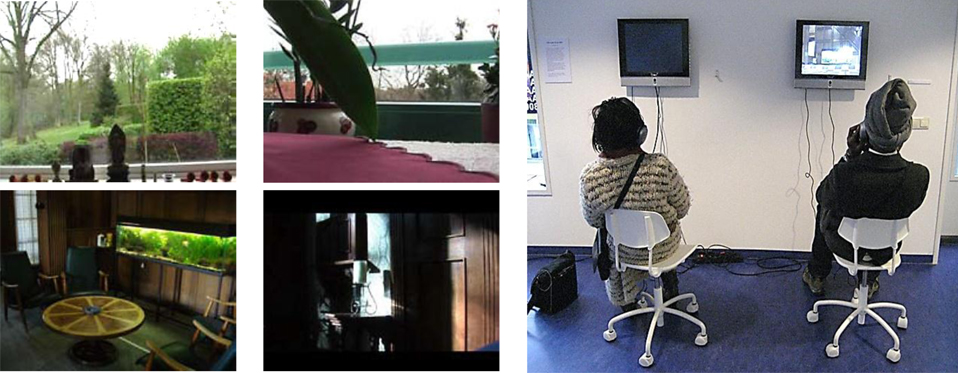
Alite Thijsen, is an artist and law graduate and lives and works in Amsterdam.
She studied at the Akademie voor Kunst en Industrie in Enschede and at the Universities of Amsterdam and Leiden (specializing in law and administration in developing countries and copyright law).
Her artwork includes drawings, paintings, installations, and videos. Since a long stay in West Africa (1984), which was facilitated by a grant from the BKVB Fund, the different aspects of intercultural dialogue have been at the core of her work.
She is the founder of Stichting ZET Amsterdam (1985), an artist’s initiative that mainly addresses the position of ‘drawing’ in contemporary art.
Stichting ZET promotes and develops international cooperation projects in a broad context with artists from among others China, Canada, Burkina Faso, Senegal, and England.